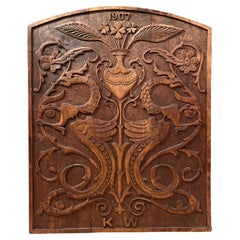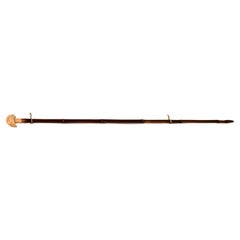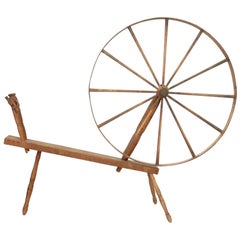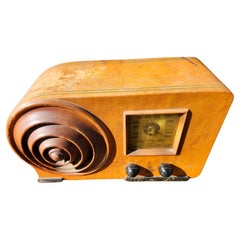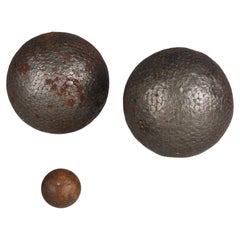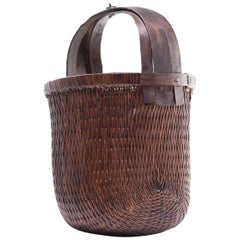Hardwood Antiquities
to
9
71
24
96
33
9
5
3
3
2
7
64
25
18
5
1
4
4
4
58,136
556
531
244
151
72
38
14
13
12
96
96
96
1
1
1
Material: Hardwood
Dated 1907 Museum-Quality Arts & Crafts Wall Cabinet, Hand-crafted Dragon Style
Located in Skien, NO
Over 100 years old Primitive Antique Norwegian Dragon Style Carved Hanging Cabinet, 1907
Description:
This rare and professionally carved hanging cabinet is a stellar example of Sca...
Category
Early 20th Century Norwegian Folk Art Hardwood Antiquities
Materials
Pine, Hardwood, Beech
Circa 1930's English Cane or Walking Stick with Bone Handle
Located in High Point, NC
Circa 1930's cane made of fruitwood with a bone handle. The bone handle is etched with a lovely floral pattern. The walking stick is hand carved to look like bamboo. Very interest...
Category
1930s English Art Deco Vintage Hardwood Antiquities
Materials
Bone, Fruitwood
J Platt Great Wheel Spinning Wheel
Located in Bradenton, FL
A large wheeled walking spinning wheel designed to be operated while standing, also known as a Great Wheel. Made by J.Platt, as marked on the end of the oak base or table, who made w...
Category
Late 18th Century American Rustic Antique Hardwood Antiquities
Materials
Wood, Ash, Oak
Art Deco Birdeye Maple Petite Radio by Emerson - Cabinet by Ingraham C1930
By Emerson Radio Corporation, Ingraham
Located in Port Jervis, NY
Fabulous and rare, timeless and very cool in original as found condition this Emerson radio is a petite model and the likes of which i have not seen before. Back of cabinet is missi...
Category
1930s American Art Deco Vintage Hardwood Antiquities
Materials
Plastic, Bakelite, Birdseye Maple
Pair Of Antique Boule Balls, Pétanque, 1880s, France, Craftsmanship
Located in Greven, DE
Beautiful, unique Boule ball pair and one target ball, France, late 19th Century.
In the 19th century, the manufacture of boules balls underwent significant development in France as...
Category
Late 19th Century French Late Victorian Antique Hardwood Antiquities
Materials
Metal
Chinese Bent Handle Fisherman's Basket, circa 1900
Located in Chicago, IL
Basket making is an ancient and humble craft, but in the hands of a skilled weaver a simple willow basket can become a truly beautiful work of art. This bent handle basket was made i...
Category
Early 20th Century Chinese Rustic Hardwood Antiquities
Materials
Willow, Bentwood
antique shepherd’s chest, 1850’s
Located in Amsterdam, Noord Holland
Low shepherd’s chest with a beautiful appearance and proportions. These chests were made in the same way for centuries. They were decorated with traditional magical geometric symbols...
Category
1850s Romanian Folk Art Antique Hardwood Antiquities
Materials
Beech
Antique Boule Ball "J P", Pétanque, 1880s, France, Craftsmanship
Located in Greven, DE
Beautiful, unique Boule ball, France, late 19th Century.
In the 19th century, the manufacture of boules balls underwent significant development in France as the game of boules, part...
Category
Late 19th Century French Late Victorian Antique Hardwood Antiquities
Materials
Metal, Brass
Antique Boule Ball "G", Pétanque, 1880s, France, Craftsmanship
Located in Greven, DE
Beautiful, unique Boule ball, France, late 19th Century.
In the 19th century, the manufacture of boules balls underwent significant development in France as the game of boules, particularly the pétanque variant, gained in popularity. The manufacture of boules balls during this period was a manual process that required expertise, precision and love to detail.
In the late 19th and early 20th centuries, particularly in rural areas of France and other Mediterranean regions, olive wood was a commonly used source of material for making boules balls. This was not only due to the availability of the material, but also to the outstanding properties of olive wood, which was characterized by hardness, strength and a rich grain.
First, the olive wood was carefully selected and shaped into raw balls, which were then sanded to the desired size and shape. The nails were then hammered into the balls one by one, making sure that they were evenly distributed and firmly anchored. Finally, the spheres were polished and coated with a protective varnish to enhance their natural beauty and protect them from the elements.
The use of nails to decorate and reinforce olive wood boules was a traditional practice that not only gave the ball a rustic aesthetic, but also improved its durability and contributed to customization. Many balls were made according to the specific requirements and preferences of the players. Nails were driven at regular intervals around the ball, with each nail hole precisely placed so as not to affect the balance and weight distribution of the ball. These nails not only served as a decorative element, but also helped to strengthen the structure of the ball and make it more resistant to the hard knocks and wear and tear during play. Individual engravings or decorations were often applied to the balls to make them unique and identify the player.
Antique boules...
Category
Late 19th Century French Late Victorian Antique Hardwood Antiquities
Materials
Metal
Art Deco Chest of Drawers from Berlin around 1930
Located in Greven, DE
Nice little chest of drawers from the German Art Deco. The combination of the black piano lacquer and the Kaukassischer walnut make this furniture an absolute eye-catcher. The entire...
Category
1930s German Art Deco Vintage Hardwood Antiquities
Materials
Brass, Chrome
$3,814 Sale Price
44% Off
Art Deco Sideboard in Rosewood from Paris Around 1925
Located in Greven, DE
We were able to acquire this wonderful piece of furniture directly from Paris. The sideboard has a wonderful rosewood veneer which, with the reddish tones, creates a nice contrast to...
Category
1920s French Art Deco Vintage Hardwood Antiquities
Materials
Marble, Chrome
$6,961 Sale Price
35% Off
19th Century English Hand-Carved Bread Board
Located in High Point, NC
19th century English bread board made from sycamore. the border is hand carved with the word bread and a hand-carved design of oak leaves and acor...
Category
19th Century English Victorian Antique Hardwood Antiquities
Materials
Sycamore
Olokun Head, Kingdom of Ife, Western Nigeria Hand Carved Hardwood
Located in Rothley, Leicestershire
Fascinating detailed Olokun head from the Kingdom of Ife in Western Nigeria.
Hand carved hardwood face with almond shaped eyes, neck creases and astounding facial incisions
Circa 1...
Category
Late 20th Century Beninese Folk Art Hardwood Antiquities
Materials
Hardwood
Antique Boule Ball Brass Decor, Pétanque, 1880s, France, Craftsmanship
Located in Greven, DE
Beautiful, unique Boule ball, France, late 19th Century.
In the 19th century, the manufacture of boules balls underwent significant development in France as the game of boules, part...
Category
Late 19th Century French Late Victorian Antique Hardwood Antiquities
Materials
Metal, Brass
19th Century Sycamore Bread Board
Located in High Point, NC
19th century bread board from England made from sycamore. The board is turned and has a molded edge. The border is hand carved with a wheat designs and has the word "Welcome" carve...
Category
19th Century English Victorian Antique Hardwood Antiquities
Materials
Sycamore
Exceptional Lancaster County Sack Back Windsor Chair
Located in Lancaster, PA
This is an exceptionally fine Lancaster, Pennsylvania Sack Back Windsor Armchair, circa 1780. It has a bowed crest rail mortised into a continuous rear rail with eleven spindles, se...
Category
Late 18th Century American Antique Hardwood Antiquities
Materials
Hardwood
Antique New England Sack Back Chair
Located in Lancaster, PA
A very fine sack back armchair, circa 1780-90. This armchair has a bowed crest rail mortised into a continuous rear rail with eleven spindles, seven of which are full height. The con...
Category
1780s North American Antique Hardwood Antiquities
Materials
Hickory, Maple, Pine
Vintage European Walking Stick with 12 Badges
Located in High Point, NC
Early 20th century hickory thorn walking stick from Europe. This walking stick has 12 badges, which were acquired by the hiker going from village to village and earning those souven...
Category
20th Century German Folk Art Hardwood Antiquities
Materials
Metal
Folk Art Walking Stick, Germany, 1890
Located in Milan, IT
Folk art walking stick: carved wooden handle depicting a Great Dane dog’s head, sulphur glass eyes. Fruit wood shaft and metal ferrule. Germany ...
Category
Late 19th Century German Antique Hardwood Antiquities
Materials
Metal
Set of 4 Antique Bilboquets, France
Located in Schellebelle, BE
Beautiful set of four antique Bilboquets from France,around 1920,
cup-and-bowl children toys in turned Beechwood, dark tinted,
pretty patina,
a set full of charm and authenticity
...
Category
1920s French Vintage Hardwood Antiquities
Materials
Beech
$1,504 / set
Antique Boule Ball "C" With Star Decor, Pétanque, 1880s, France, Craftsmanship
Located in Greven, DE
Beautiful, unique Boule ball, France, late 19th Century.
In the 19th century, the manufacture of boules balls underwent significant development in France as the game of boules, part...
Category
Late 19th Century French Late Victorian Antique Hardwood Antiquities
Materials
Metal, Brass
1800s Ancient Icelandic "Askur", Primitive Museum-Quality Early Antique
Located in Skien, NO
Extremely Rare Antique Icelandic Askur Jar with Lid (ca. 1800–1850s) – Museum-Quality Collectible
This exceptional Askur, a traditional Icelandic food storage container, is a rare a...
Category
Early 19th Century Icelandic Folk Art Antique Hardwood Antiquities
Materials
Wood, Ash, Pine
English Edwardian Riding Crop, Circa 1900
Located in High Point, NC
Edwardian riding crop from England with a handle made from bone and a leather whip. The bone handle is attached with a silver collar to the crop, giving it a lovely dimensional look...
Category
Early 1900s English Edwardian Antique Hardwood Antiquities
Materials
Bone, Leather, Hickory
Chinese Woven Garden Basket, c. 1900
Located in Chicago, IL
It is easy to imagine someone, long ago, gathering a harvest from their garden or strolling to the market with this beautiful basket tucked under their arm. Hand-woven of young willo...
Category
Early 20th Century Chinese Rustic Hardwood Antiquities
Materials
Willow, Bentwood
Antique boxwood Art Nouveau corkscrew, France 1900.
Located in Milan, IT
Antique Art Nouveau corkscrew made of hand carved boxwood, depicting plant branches enveloping the knob with brass flowers at either end of the T. The corkscrew worm is made of iron ...
Category
Early 20th Century French Hardwood Antiquities
Materials
Brass, Iron
A Carved boxwood spoon - late 19th century - France.
Located in SOTTEVILLE-LÈS-ROUEN, FR
Carved boxwood spoon, likely from the late 19th century, handcrafted in France as a monoxylous piece with a beautiful patina. Fine example of French folk...
Category
Late 19th Century French Folk Art Antique Hardwood Antiquities
Materials
Boxwood
$269 Sale Price
20% Off
Ivory handle walking stick depicting Mephistopheles face, England 1870.
Located in Milan, IT
Walking stick: ivory carved handle. The handle depicts a caricatural face of Mephistopheles. Ebonized fruitwood shaft rustic shape. Silver ring. Metal ferrule. England circa 1870. (S...
Category
Late 19th Century English Antique Hardwood Antiquities
Materials
Metal, Silver
Antique Boule Set, Boule Balls, Pétanque, 1880s, France, Craftsmanship
Located in Greven, DE
Beautiful, unique Boule set of three Boule balls and one target ball, France, late 19th century.
In the 19th century, the manufacture of boule balls underwent significant developmen...
Category
Late 19th Century French Late Victorian Antique Hardwood Antiquities
Materials
Olive
Walking stick, silver handle depicting an elephant head, Germany 1890.
Located in Milan, IT
Walking stick: silver and bone knob, which depicts at its end an elephant head with rolled trunk in pure Art Nouveau style. Bone fangs and sulfur glass eyes. Wooden barrel painted bl...
Category
Late 19th Century German Antique Hardwood Antiquities
Materials
Silver
19thc Hay Fork from Pennsylvania
Located in Los Angeles, CA
This hand carved and crafted hay fork was found in Pennsylvania on a farm.The condition is very good and sturdy.
Category
Mid-19th Century American Country Antique Hardwood Antiquities
Materials
Hickory
System walking stick with thimble holder function, USA 1900.
Located in Milan, IT
System walking stick, flamed fruit wood barrel, with 925/1000 sterling silver knob and band, acting as a container for a sewing thimble. Brass tip. United...
Category
Early 20th Century American Hardwood Antiquities
Materials
Sterling Silver, Brass
Framed Collection of Mesoamerican Pre-Classic Period Sculptures & Arrow Heads
Located in New York, NY
Incredible collection of pre-columbian clay sculptures / figures / statues / pottery, mounted and framed. The pieces date from the pre-classic (Formative) period of Meso-American cul...
Category
15th Century and Earlier North American Pre-Columbian Antique Hardwood Antiquities
Materials
Clay, Precious Stone, Hardwood
Folk art walking stick depicting a man with a snake. USA circa 1870.
Located in Milan, IT
Folk art walking stick: a piece of fruitwood depicting the bust of a Native American with a snake carved along the curved shaft and painted green. The eyes of the Native American and...
Category
Late 19th Century American Antique Hardwood Antiquities
Materials
Fruitwood
Gadget-system walking stick with bag holder function, Marktroller, Germany, 1920
Located in Milan, IT
Gadget-System cane: cane with bag holder function. Curious stick used to carry shopping bags, made with two upside-down V-shaped fruitwooden shafts, ending...
Category
Early 20th Century German Hardwood Antiquities
Materials
Iron
Art Deco Sideboard Made of Rosewood with Brass Applications, Paris, around 1920
Located in Greven, DE
Original Art Deco furniture from a time full of life and elegance. We get all of our furniture unrestored so that we can be sure that it is really original. We then offer these as original until we recondition the furniture in our workshop and then offer it as restored furniture...
Category
1920s French Art Deco Vintage Hardwood Antiquities
Materials
Brass
$3,468 Sale Price
50% Off
Horne handle walking stick, France 1880.
Located in Milan, IT
Walking stick: a carved stag horn handle depicting a caricature of an old man with big nose. Smooth silver ring. Rosewood shaft. France 1880 ca.
Category
Late 19th Century French Antique Hardwood Antiquities
Materials
Silver
Fine and Rare Early 19th Century Carved Bootjack in the Form of a Pistol
Located in Oxfordshire, United Kingdom
A fine and rare !9th Century hand carved antique treen bootjack, to remove riding boots, in the unusual form of a pistol.
This is a rare find and unfolds to form a bootjack with be...
Category
19th Century Antique Hardwood Antiquities
Materials
Beech
Circa 1907 riding Crop with Sterling Collar
Located in High Point, NC
Circa 1907 English riding crop made from hickory. The handle is made from horn, and is joined to the hickory shaft with a sterling collar. The collar...
Category
Early 1900s English Edwardian Antique Hardwood Antiquities
Materials
Sterling Silver
Complete Set Of Antique Boule Balls, 8 Pieces, Pétanque, 1880s, France
Located in Greven, DE
Complete Boule ball set of 8 pieces, France, late 19th Century.
In the 19th century, the manufacture of boules balls underwent significant development in France as the game of boule...
Category
Late 19th Century French Late Victorian Antique Hardwood Antiquities
Materials
Metal
ANTIQUE CIRCA 1800 PRiMITIVE FOLK ART HEMP CUTTING MACHINE VERY DECORATIVE PIECE
Located in West Sussex, Pulborough
Royal House Antiques
Royal House Antiques is delighted to offer for sale this wonderfully primitive fruitwood hemp cutting machine circa 1800
Please note the delivery fee listed is...
Category
Early 1800s European Georgian Antique Hardwood Antiquities
Materials
Fruitwood
A 1700s Norwegian Lion Tankard
Located in Skien, NO
A rare and exquisite primitive tankard from Norway, crafted from birch wood / hardwood with remarkable hand-carved details. This exceptional piece features a lion figurine elegantly ...
Category
Mid-18th Century Norwegian Baroque Antique Hardwood Antiquities
Materials
Birch, Nutwood, Wood
$3,200 Sale Price
20% Off
Antique Boule Ball "G", "J", Pétanque, 1880s, France, Craftsmanship
Located in Greven, DE
Beautiful, unique Boule ball, France, late 19th Century.
Decorated with the initials "G" and "J".
In the 19th century, the manufacture of boules balls underwent significant developm...
Category
Late 19th Century French Late Victorian Antique Hardwood Antiquities
Materials
Olive
Side Table of Chestnut with Carved Lyre Base Form, Spain
Located in Mombuey, Zamora
Museum quality
Clearance, exchange of items. We welcome serious offers.
Console or side table of chestnut with carved lyre base and forged iron Stretcher, Spanish 18th century.
It ...
Category
19th Century Spanish Baroque Antique Hardwood Antiquities
Materials
Iron
Circa 1920's English Riding Crop
Located in High Point, NC
Circa 1920's hickory riding crop from England. The handle is made from bone, which has been artfully cross-hatched for added design interest. The handle is attached to the crop by ...
Category
1920s English Edwardian Vintage Hardwood Antiquities
Materials
Bone, Leather, Hickory
Shagreen etui case, London circa 1800.
Located in Milan, IT
A very fine English Etui Case with original period fitting. The etui is carved in fruitwood and covered in a dark grey shagreen (Pastinachus sephen, Forrskål 1775) covering. It opens by pushing the button on the side. Finished in silver, the inner grid shows a series of cut-out seats for the insertion of the fitting, which includes a pencil, one bodkin, an ear pick...
Category
Late 19th Century English Antique Hardwood Antiquities
Materials
Silver
Pair Of Antique Boule Balls "3", Pétanque, 1880s, France, Craftsmanship
Located in Greven, DE
Beautiful, unique Boule ball pair and one target ball, France, late 19th Century.
Decorated with the numer "3" on each of the Boule balls.
In the 19th century, the manufacture of b...
Category
Late 19th Century French Late Victorian Antique Hardwood Antiquities
Materials
Olive
Antique Boule Balls Set "9", Pétanque, 1880s, France, Craftsmanship
Located in Greven, DE
Beautiful, unique Boule set of three Boule balls and one target ball, France, late 19th century.
In the 19th century, the manufacture of boules balls underwent significant development in France as the game of boules, particularly the pétanque variant, gained in popularity. The manufacture of boules balls during this period was a manual process that required expertise, precision and love to detail.
In the late 19th and early 20th centuries, particularly in rural areas of France and other Mediterranean regions, olive wood was a commonly used source of material for making boules balls. This was not only due to the availability of the material, but also to the outstanding properties of olive wood, which was characterized by hardness, strength and a rich grain.
First, the olive wood was carefully selected and shaped into raw balls, which were then sanded to the desired size and shape. The nails were then hammered into the balls one by one, making sure that they were evenly distributed and firmly anchored. Finally, the spheres were polished and coated with a protective varnish to enhance their natural beauty and protect them from the elements.
The use of nails to decorate and reinforce olive wood boules was a traditional practice that not only gave the ball a rustic aesthetic, but also improved its durability and contributed to customization. Many balls were made according to the specific requirements and preferences of the players. Nails were driven at regular intervals around the ball, with each nail hole precisely placed so as not to affect the balance and weight distribution of the ball. These nails not only served as a decorative element, but also helped to strengthen the structure of the ball and make it more resistant to the hard knocks and wear and tear during play. Individual engravings or decorations were often applied to the balls to make them unique and identify the player.
Antique boules...
Category
Late 19th Century French Late Victorian Antique Hardwood Antiquities
Materials
Olive
Asian Woven Grain Basket
Located in Greenwich, CT
Asian woven grain & rice basket
Category
Early 1900s Chinese Qing Antique Hardwood Antiquities
Materials
Reed, Willow
Large Set Of Antique Boule Balls, 13 Pieces, Pétanque, 1880s, France
Located in Greven, DE
Large Boule ball set of 13 pieces, France, late 19th Century.
Unrestored, original condition with signs of age and use.
In the 19th century, the manufacture of boules balls underwen...
Category
Late 19th Century French Late Victorian Antique Hardwood Antiquities
Materials
Metal, Copper, Steel
1800s Norwegian folk art Box, Hand-carved by Ole Olsen Moene (1839-1908)
Located in Skien, NO
Exceptional 19th Century Norwegian Folk Art Tobacco Box by Ole Olsen Moene - Museum Quality
This remarkable 19th-century Norwegian folk art tobacco box, dating from the late 1800s, ...
Category
Late 19th Century Norwegian Folk Art Antique Hardwood Antiquities
Materials
Birch, Nutwood, Beech, Bentwood
$6,800 Sale Price
20% Off
Pair Of Antique Boule Balls "3", "V", Pétanque, 1880s, France, Craftsmanship
Located in Greven, DE
Beautiful, unique Boule ball pair, France, late 19th Century.
Decorated with the numer "3" on each ball and with a "V" on one of the Boule balls.
In the 19th century, the manufactur...
Category
Late 19th Century French Late Victorian Antique Hardwood Antiquities
Materials
Olive
Antique Boule Ball "17", Pétanque, 1880s, France, Craftsmanship
Located in Greven, DE
Beautiful, unique Boule ball, France, late 19th Century.
In the 19th century, the manufacture of boules balls underwent significant development in France as the game of boules, part...
Category
Late 19th Century French Late Victorian Antique Hardwood Antiquities
Materials
Metal
Erotic folk art walking stick depicting a man in act of praying, England 1850.
Located in Milan, IT
Erotic folk-art walking stick, made from a single carved fruitwood branch. The knob depicts a man standing in the act of praying with folded hands and a large caricature head with a ...
Category
Mid-19th Century English Antique Hardwood Antiquities
Materials
Brass
Antique Boule Balls Set "B", Pétanque, 1880s, France, Craftsmanship
Located in Greven, DE
Beautiful, unique Boule set of three Boule balls and one target ball, France, late 19th century.
In the 19th century, the manufacture of boules balls underwent significant development in France as the game of boules, particularly the pétanque variant, gained in popularity. The manufacture of boules balls during this period was a manual process that required expertise, precision and love to detail.
In the late 19th and early 20th centuries, particularly in rural areas of France and other Mediterranean regions, olive wood was a commonly used source of material for making boules balls. This was not only due to the availability of the material, but also to the outstanding properties of olive wood, which was characterized by hardness, strength and a rich grain.
First, the olive wood was carefully selected and shaped into raw balls, which were then sanded to the desired size and shape. The nails were then hammered into the balls one by one, making sure that they were evenly distributed and firmly anchored. Finally, the spheres were polished and coated with a protective varnish to enhance their natural beauty and protect them from the elements.
The use of nails to decorate and reinforce olive wood boules was a traditional practice that not only gave the ball a rustic aesthetic, but also improved its durability and contributed to customization. Many balls were made according to the specific requirements and preferences of the players. Nails were driven at regular intervals around the ball, with each nail hole precisely placed so as not to affect the balance and weight distribution of the ball. These nails not only served as a decorative element, but also helped to strengthen the structure of the ball and make it more resistant to the hard knocks and wear and tear during play. Individual engravings or decorations were often applied to the balls to make them unique and identify the player.
Antique boules...
Category
Late 19th Century French Late Victorian Antique Hardwood Antiquities
Materials
Olive
English Edwardian Riding Crop, Circa 1900
Located in High Point, NC
English Edwardian riding crop made from hickory. The handle is made from bone and is cross hatched in design for easier gripping to the rider. The horn is attached to the handle wi...
Category
Early 1900s English Edwardian Antique Hardwood Antiquities
Materials
Bone, Leather, Hickory
19thc Bird’S-Eye Maple Compote with Stone Fruit
Located in Los Angeles, CA
Each Fruit measures between 2.5 and 3 inches spherically. There is a collection of seven alabaster hand painted peaches and is in a burl or bird...
Category
Late 19th Century American Adirondack Antique Hardwood Antiquities
Materials
Stone
$1,295 / set
Antique Boule Ball "6", Pétanque, 1880s, France, Craftsmanship
Located in Greven, DE
Beautiful, unique Boule ball, France, late 19th Century.
In the 19th century, the manufacture of boules balls underwent significant development in France as the game of boules, part...
Category
Late 19th Century French Late Victorian Antique Hardwood Antiquities
Materials
Metal, Brass
Antique Boule Ball "G", Pétanque, 1880s, France, Craftsmanship
Located in Greven, DE
Beautiful, unique Boule ball, France, late 19th Century.
In the 19th century, the manufacture of boules balls underwent significant development in France as the game of boules, particularly the pétanque variant, gained in popularity. The manufacture of boules balls during this period was a manual process that required expertise, precision and love to detail.
In the late 19th and early 20th centuries, particularly in rural areas of France and other Mediterranean regions, olive wood was a commonly used source of material for making boules balls. This was not only due to the availability of the material, but also to the outstanding properties of olive wood, which was characterized by hardness, strength and a rich grain.
First, the olive wood was carefully selected and shaped into raw balls, which were then sanded to the desired size and shape. The nails were then hammered into the balls one by one, making sure that they were evenly distributed and firmly anchored. Finally, the spheres were polished and coated with a protective varnish to enhance their natural beauty and protect them from the elements.
The use of nails to decorate and reinforce olive wood boules was a traditional practice that not only gave the ball a rustic aesthetic, but also improved its durability and contributed to customization. Many balls were made according to the specific requirements and preferences of the players. Nails were driven at regular intervals around the ball, with each nail hole precisely placed so as not to affect the balance and weight distribution of the ball. These nails not only served as a decorative element, but also helped to strengthen the structure of the ball and make it more resistant to the hard knocks and wear and tear during play. Individual engravings or decorations were often applied to the balls to make them unique and identify the player.
Antique boules...
Category
Late 19th Century French Late Victorian Antique Hardwood Antiquities
Materials
Metal
Vintage Hickory Walking Stick with Three Badges
Located in High Point, NC
Circa 1940-1960 hickory walking stick with three badges. These badges were earned while walking through towns in the mountainous regions of Germany and Switzerland. The badges are ...
Category
Mid-20th Century German Folk Art Hardwood Antiquities
Materials
Hickory
Art Nouveau boxwood whistle depicting a smiling face, France end of 19th century
Located in Milan, IT
An Art Nouveau whistle made of carved Boxwood, depicting a smiling face of a blindfolded woman. The terminal part, the actual whistle, is made of deer horn, engraved with the phrase ...
Category
Late 19th Century French Antique Hardwood Antiquities
Materials
Horn, Boxwood
Recently Viewed
View AllMore Ways To Browse
Ribbed Cabinet
Robert Burns Antique
Robert Irwin
Rococo Burl Wood
Russian Double Headed Eagle
Sandoz Bronze
Satsuma Moriage
Scandinavian China Cabinet
Scottish Deer
Scottish Stag
Sculpture Renaissance Lion
Secretary Desk Federal
Seguso Duck
Seguso Glass Duck
Sheep Sculpture Bronze
Sligh Furniture Mid Century
Soapstone Seal
Solid Silver Animals
